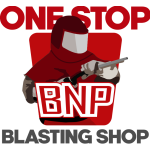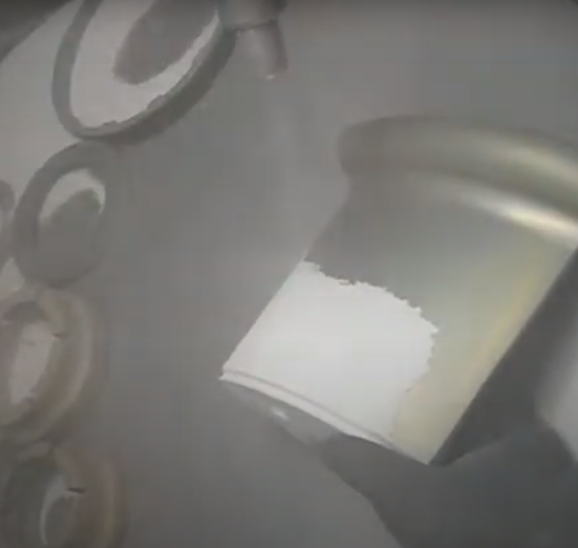What is Plastic Media Blasting?
With operators dressed as spacemen, gigantic industrial machinery and paint magically disappearing right before your eyes, many customers want to know more about our plastic media paint stripping process.
The process is similar in principle to sandblasting, a process that has been in industrial use for over 100 years.
Traditional Sandblasting
A specially designed pressure vessel (blasting pot) is filled with abrasive and compressed air. The abrasive is then slowly metered from the blasting pot and into a pressurised blast hose fitted below. As it enters the hose, high pressure compressed air sweeps it up and conveys it at increasing speed through the hose towards the blast nozzle, fitted to the end of the hose. The venturi blast nozzle further accelerates the abrasive from 170km/hr to a final exit velocity of 675km/hr.
These millions of abrasive particles, moving at super high speed, are then projected onto the workpiece to be blasted. Depending on the type of abrasive being used, the material the part is made of, and the blasting parameters selected, these high-velocity abrasive grains do their work, be it; cleaning, etching, paint stripping, frosting, smoothing, surface finishing or peening etc.
And so plastic media paint stripping is based on this same abrasive blasting principle, with machinery and process parameters modified to handle the special plastic media abrasive.
Plastic Media Blasting Process
Plastic Media Blasting is an environmentally friendly, fast and economical method of paint and coating stripping, without using any harmful or toxic chemicals to remove the coating. Millions of tiny granular particles of plastic, shaped like sand, are blasted onto the workpiece by a compressed air blasting system. The high-speed plastic particles effectively cut through, chip-off and pulverise the paint or coating to be removed. The sharp, jagged, angular edges of the plastic media provide a fast cutting action, but as the plastic is softer than the underlying material no damage is incurred on the substrate surface.
The surface under the removed coating is not etched, scratched, marred or warped in any way. All materials including steel, aluminum, plastics, glass, wood, composites and fiberglass can be safely and rapidly stripped without damaging surfaces. Intricate parts and soft materials are not eroded or damaged with plastic media blasting.
Unlike the conventional abrasive blasting processes mentioned earlier, plastic media blasting is a much gentler and softer process. The principles of operation are the same but additional parameters and controls are
implemented to ensure effective coating removal without substrate damage.
Each work-piece to be blasted is evaluated to determine the most effective blasting settings. The hardness of work-piece, type of plastic media, air pressure, angle of attack, abrasive flow rate, nozzle size and type, stand-off distance etc are all parameters that are tightly controlled to ensure successful coating stripping.
Uses and Applications
Plastic media blasting is best suited for applications of paint and coating stripping where the underlying surface cannot be damaged or etched. Unlike conventional abrasive blasting, the process does not etch or profile the substrate for a coating to adhere to.
The process is very fast. Compared to other coating stripping methods plastic media blasting can remove the coating in a fraction of the time. What would take workers days to accomplish by hand stripping methods can be completed in mere hours with PMB.
Some examples of products and processes suitable for plastic media stripping include:
> paint removal from car panels
> vintage car restoration paint removal
> bicycle and motorcycle frame paint removal
> aircraft skin and component paint removal
> aircraft wheel and landing gear paint removal before inspection
> alloy wheel paint and powder coat removal
> composite aircraft parts paint removal
> injection mold cleaning
> powder coating removal
> aluminium and fiberglass boat paint removal
> composite and fiberglass part paint removal
> helicopter parts paint stripping
> garden furniture paint removal before repainting
> wood furniture varnish removal
> antiquities cleaning and restoration
Plastic Media Material
The material for plastic media is produced in various types to suit various blasting requirements:
Type V Acrylic – Hardness 3 – 3.5 Moh
The softest and gentlest of the range is suitable for delicate or thin parts or items with galvanic coating on the substrate. Provides a very gentle and smooth blast on the surface to maintain surface integrity. Thinner fiberglass, aluminium and thermoset plastic parts are especially suited for this plastic media.
Type II Urea – Hardness 3.5 Moh
Suitable for most metal surfaces and a wide range of applications. Used for efficient cleaning and stripping off paint from all kinds of surfaces such as metals, fiberglass and composites, sheet metal steel etc. A very versatile abrasive for most applications including paint stripping of cars, aircraft parts, graffiti, trucks, and decarbonising of engine parts.
Type III Melamine – Hardness 3.5 – 4 Moh
Melamine is the hardest and most aggressive of the plastic medias we use. Blasts faster when used on less sensitive more tolerant underlying surfaces. The harder grit particles are more effective in removing thicker and harder coatings and baked on residues and provide faster blasting speeds without damage to the parts. Better for removal of stubborn paints, coatings and carbon deposits.
Advantages
Plastic media blasting offers an alternative to several other coating removal systems such as acid chemical and acid paint strippers, manual sanding, incineration oven and slat baths etc. All of these are inefficient, expensive and environmentally unfriendly. Furthermore chemical and acids strippers expose workers to potential health dangers and require expensive responsible disposal after use.
Plastic media blasting eliminates all the above safety, process and environmental issues and provides a safe, fast, and environmentally friendly paint and coating stripping system.
Chemical and acid strippers require parts to be soaked for hours, if not days, to soften the coating before scraping it off. Often the process must be repeated multiple times to remove thick coatings. On complex-shaped parts it is very difficult to get into all the cavities, corners and recesses to fully remove the coating, thus leaving the part incompletely cleaned. Paint stripping with plastic media can be performed as and when is required. No special preparation or pre-soaking is required. The only preparation required is to ensure the parts are oil-free. Parts can be immediately paint stripped, removing 100% of the paint regardless of the part shape or difficult to access areas.
Furthermore, the waste generated to remove the coating is virtually zero. You do not end up with a container load of contaminated acid chemical waste to dispose of. Plastic media blasting is performed in equipment that continuously recycles the media and separates waste from good reusable abrasive. The only waste generated is the residue of the pulverized coating that has been removed. This is collected into a waste drum ready for disposal at a later date.
Manual stripping with sanding paper and power tools is time-consuming and subject to operator skill to prevent damage or etching to the underlying surface from power tools. What would takes days to sand down manually with sandpaper can be accomplished within minutes or hours with plastic media blasting.
Recyclability and Waste
Plastic media blasting creates no pollution during the process, and produces virtually no waste to dispose of. The paint stripping is conducted within a blast cabinet, or for bigger parts within a blastroom. These machines are connected to large dust collectors that evacuate the air from the cabinet to prevent dust pollution to the atmosphere during blasting. As the parts are being processed all the abrasive and paint removed from the surface is passed through recycling equipment that separates the waste pulverized paint dust from good reusable abrasive, which is then recycled for blasting.
The low breakdown rate of only up to 5% per cycle ensures minimal waste is generated.
The plastic media is made from fully cured, non-toxic thermoset plastic compounds. Once broken down into dust, the dry waste generated is non-hazardous.

